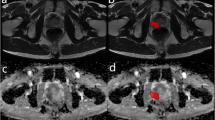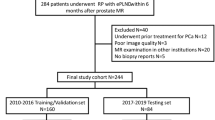Abstract
Purpose
To investigate and validate the potential role of a radiomics signature in predicting the side-specific probability of extracapsular extension (ECE) of prostate cancer (PCa).
Procedures
The preoperative magnetic resonance imaging data of 238 prostatic samples from 119 enrolled PCa patients were retrospectively assessed. The samples with were randomized in a two-to-one ratio into training (n = 74) and validation (n = 45) datasets. The radiomics features were derived from T2-weighted images (T2WIs). The optimal radiomics features were identified from the least absolute shrinkage and selection operator (LASSO) logistic regression model and were used to construct a predictive radiomics signature via dimension reduction and selection approaches. The association between the radiomics signatures and pathological ECE status was explored. Receiver operating characteristic (ROC) analysis was used to assess the discriminatory ability of the signature. The calibration performance and clinical usefulness of the radiomics signature were subsequently assessed by calibration curve and decision curve analyses.
Results
The proposed radiomics signature that incorporated 17 selected radiomics features was significantly associated with pathological ECE outcomes (P < 0.001) in both the training and validation datasets. The constructed model displayed good discrimination, with areas under the curve (AUC) of 0.906 (95 % confidence interval (CI), 0.847, 0.948) and 0.821 (95 % CI, 0.726, 0.894) for the training and validation datasets, respectively, and had a good calibration performance. The clinical utility of this model was confirmed through decision curve analysis.
Conclusions
The radiomics signature based on T2WIs showed the potential to predict the side-specific probability of pathological ECE status and can facilitate the preoperative individualized predictions for PCa patients.





Similar content being viewed by others
References
Boehmer D, Maingon P, Poortmans P, Baron MH, Miralbell R, Remouchamps V, Scrase C, Bossi A, Bolla M, EORTC radiation oncology group (2006) Guidelines for primary radiotherapy of patients with prostate cancer. Radiother Oncol 79:259–269
Roethke MC, Lichy MP, Kniess M, Werner MK, Claussen CD, Stenzl A, Schlemmer HP, Schilling D (2013) Accuracy of preoperative endorectal MRI in predicting extracapsular extension and influence on neurovascular bundle sparing in radical prostatectomy. World J Urol 31:1111–1116
Cooperberg MR, Lubeck DP, Mehta SS, Carroll PR (2003) Time trends in clinical risk stratification for prostate cancer: implications for outcomes (data from CaPSURE). J Urol 170:S21–S25 discussion S26-27
Han M, Partin AW, Piantadosi S, Epstein JI, Walsh PC (2001) Era specific biochemical recurrence-free survival following radical prostatectomy for clinically localized prostate cancer. J Urol 166:416–419
Eifler JB, Feng Z, Lin BM, Partin MT, Humphreys EB, Han M, Epstein JI, Walsh PC, Trock BJ, Partin AW (2013) An updated prostate cancer staging nomogram (Partin tables) based on cases from 2006 to 2011. BJU Int 111:22–29
Center MSKC. Prostate cancer nomograms: pre-radical prostatectomy. https:// www.mskcc.org/nomograms/prostate/pre_op. Accessed 14 July 2019
Cerantola Y, Valerio M, Kawkabani Marchini A, Meuwly JY, Jichlinski P (2013) Can 3T multiparametric magnetic resonance imaging accurately detect prostate cancer extracapsular extension? Can Urol Assoc J 7:E699–E703
Feng TS, Sharif-Afshar AR, Smith SC et al (2015) Multiparametric magnetic resonance imaging localizes established extracapsular extension of prostate cancer. Urol Oncol 33:109.e115–109.e122
Freifeld Y, Diaz de Leon A, Xi Y, Pedrosa I, Roehrborn CG, Lotan Y, Francis F, Costa DN (2019) Diagnostic performance of prospectively assigned Likert scale scores to determine extraprostatic extension and seminal vesicle invasion with multiparametric MRI of the prostate. AJR Am J Roentgenol 212:576–581
Gupta RT, Faridi KF, Singh AA, Passoni NM, Garcia-Reyes K, Madden JF, Polascik TJ (2014) Comparing 3-T multiparametric MRI and the Partin tables to predict organ-confined prostate cancer after radical prostatectomy. Urol Oncol 32:1292–1299
Augustin H, Fritz GA, Ehammer T, Auprich M, Pummer K (2009) Accuracy of 3-Tesla magnetic resonance imaging for the staging of prostate cancer in comparison to the Partin tables. Acta Radiol 50:562–569
de Rooij M, Hamoen EH, Witjes JA et al (2016) Accuracy of magnetic resonance imaging for local staging of prostate cancer: a diagnostic meta-analysis. Eur Urol 70:233–245
Ruprecht O, Weisser P, Bodelle B, Ackermann H, Vogl TJ (2012) MRI of the prostate: interobserver agreement compared with histopathologic outcome after radical prostatectomy. Eur J Radiol 81:456–460
Weinreb JC, Barentsz JO, Choyke PL, Cornud F, Haider MA, Macura KJ, Margolis D, Schnall MD, Shtern F, Tempany CM, Thoeny HC, Verma S (2016) PI-RADS prostate imaging—reporting and data system: 2015, version 2. Eur Urol 69:16–40
Nketiah G, Elschot M, Kim E, Teruel JR, Scheenen TW, Bathen TF, Selnæs KM (2017) T2-weighted MRI-derived textural features reflect prostate cancer aggressiveness: preliminary results. Eur Radiol 27:3050–3059
Wibmer A, Hricak H, Gondo T, Matsumoto K, Veeraraghavan H, Fehr D, Zheng J, Goldman D, Moskowitz C, Fine SW, Reuter VE, Eastham J, Sala E, Vargas HA (2015) Haralick texture analysis of prostate MRI: utility for differentiating non-cancerous prostate from prostate cancer and differentiating prostate cancers with different Gleason scores. Eur Radiol 25:2840–2850
Ma S, Xu K, Xie H, Wang H, Wang R, Zhang X, Wei J, Wang X (2018) Diagnostic efficacy of b value (2000 s/mm(2)) diffusion-weighted imaging for prostate cancer: comparison of a reduced field of view sequence and a conventional technique. Eur J Radiol 107:125–133
Chaddad A, Kucharczyk MJ, Niazi T (2018) Multimodal radiomic features for the predicting Gleason score of prostate cancer. Cancers (Basel) 10:E249
Chaddad A, Niazi T, Probst S, Bladou F, Anidjar M, Bahoric B (2018) Predicting Gleason score of prostate cancer patients using radiomic analysis. Front Oncol 8:630
Khalvati F, Zhang J, Chung AG, Shafiee MJ, Wong A, Haider MA (2018) MPCaD: a multi-scale radiomics-driven framework for automated prostate cancer localization and detection. BMC Med Imaging 18:16
Mayerhoefer ME, Szomolanyi P, Jirak D, Materka A, Trattnig S (2009) Effects of MRI acquisition parameter variations and protocol heterogeneity on the results of texture analysis and pattern discrimination: an application-oriented study. Med Phys 36:1236–1243
Baessler B, Weiss K, Pinto Dos Santos D (2019) Robustness and reproducibility of radiomics in magnetic resonance imaging: a phantom study. Investig Radiol 54:221–228
Collewet G, Strzelecki M, Mariette F (2004) Influence of MRI acquisition protocols and image intensity normalization methods on texture classification. Magn Reson Imaging 22:81–91
Bostwick DG, Montironi M (1997) Evaluating radical prostatectomy specimens: therapeutic and prognostic importance. Virchows Arch 430:1–16
Epstein JI, Allsbrook WC Jr, Amin MB, Egevad LL (2005) The 2005 International Society of Urological Pathology (ISUP) consensus conference on Gleason grading of prostatic carcinoma. Am J Surg Pathol 29:1228–1242
Magi-Galluzzi C, Evans AJ, Delahunt B et al (2011) International Society of Urological Pathology (ISUP) consensus conference on handling and staging of radical prostatectomy specimens. Working group 3: extraprostatic extension, lymphovascular invasion and locally advanced disease. Mod Pathol 24:26–38
Vallieres M, Freeman CR, Skamene SR, El Naqa I (2015) A radiomics model from joint FDG-PET and MRI texture features for the prediction of lung metastases in soft-tissue sarcomas of the extremities. Phys Med Biol 60:5471–5496
Park HJ, Lee SS, Park B, Yun J, Sung YS, Shim WH, Shin YM, Kim SY, Lee SJ, Lee MG (2019) Radiomics analysis of gadoxetic acid-enhanced MRI for staging liver fibrosis. Radiology 290:380–387
Sauerbrei W, Royston P, Binder H (2007) Selection of important variables and determination of functional form for continuous predictors in multivariable model building. Stat Med 26:5512–5528
Kramer AA, Zimmerman JE (2007) Assessing the calibration of mortality benchmarks in critical care: the Hosmer-Lemeshow test revisited. Crit Care Med 35:2052–2056
Steyerberg EW, Vickers AJ (2008) Decision curve analysis: a discussion. Med Decis Mak 28:146–149
Vickers AJ, Cronin AM, Elkin EB, Gonen M (2008) Extensions to decision curve analysis, a novel method for evaluating diagnostic tests, prediction models and molecular markers. BMC Med Inform Decis Mak 8:53
Bolla M, van Poppel H, Tombal B, Vekemans K, da Pozzo L, de Reijke TM, Verbaeys A, Bosset JF, van Velthoven R, Colombel M, van de Beek C, Verhagen P, van den Bergh A, Sternberg C, Gasser T, van Tienhoven G, Scalliet P, Haustermans K, Collette L (2012) Postoperative radiotherapy after radical prostatectomy for high-risk prostate cancer: long-term results of a randomised controlled trial (EORTC trial 22911). Lancet 380:2018–2027
Cooperberg MR, Pasta DJ, Elkin EP et al (2005) The University of California, San Francisco Cancer of the Prostate Risk Assessment score: a straightforward and reliable preoperative predictor of disease recurrence after radical prostatectomy. J Urol 173:1938–1942
Feng TS, Sharif-Afshar AR, Wu J, Li Q, Luthringer D, Saouaf R, Kim HL (2015) Multiparametric MRI improves accuracy of clinical nomograms for predicting extracapsular extension of prostate cancer. Urology 86:332–337
Morlacco A, Sharma V, Viers BR, Rangel LJ, Carlson RE, Froemming AT, Karnes RJ (2017) The incremental role of magnetic resonance imaging for prostate cancer staging before radical prostatectomy. Eur Urol 71:701–704
Sighinolfi MC, Sandri M, Torricelli P, Ligabue G, Fiocchi F, Scialpi M, Eissa A, Reggiani Bonetti L, Puliatti S, Bianchi G, Rocco B (2019) External validation of a novel side-specific, multiparametric magnetic resonance imaging-based nomogram for the prediction of extracapsular extension of prostate cancer: preliminary outcomes on a series diagnosed with mpMRI targeted plus systematic saturation biopsy. BJU Int. https://doi.org/10.1111/bju.14665
Somford DM, Hamoen EH, Futterer JJ et al (2013) The predictive value of endorectal 3 Tesla multiparametric magnetic resonance imaging for extraprostatic extension in patients with low, intermediate and high risk prostate cancer. J Urol 190:1728–1734
Xie H, Zhang X, Ma S, Liu Y, Wang X (2019) Preoperative differentiation of uterine sarcoma from leiomyoma: comparison of three models based on different segmentation volumes using radiomics. Mol Imaging Biol. https://doi.org/10.1007/s11307-019-01332-7
Huang YQ, Liang CH, He L, Tian J, Liang CS, Chen X, Ma ZL, Liu ZY (2016) Development and validation of a radiomics nomogram for preoperative prediction of lymph node metastasis in colorectal cancer. J Clin Oncol 34:2157–2164
Aerts HJ, Velazquez ER, Leijenaar RT et al (2014) Decoding tumour phenotype by noninvasive imaging using a quantitative radiomics approach. Nat Commun 5:4006
Fehr D, Veeraraghavan H, Wibmer A, Gondo T, Matsumoto K, Vargas HA, Sala E, Hricak H, Deasy JO (2015) Automatic classification of prostate cancer Gleason scores from multiparametric magnetic resonance images. Proc Natl Acad Sci U S A 112:E6265–E6273
Wang J, Wu CJ, Bao ML, Zhang J, Wang XN, Zhang YD (2017) Machine learning-based analysis of MR radiomics can help to improve the diagnostic performance of PI-RADS v2 in clinically relevant prostate cancer. Eur Radiol 27:4082–4090
Ma S, Xie H, Wang H, Han C, Yang J, Lin Z, Li Y, He Q, Wang R, Cui Y, Zhang X, Wang X (2019) MRI-based radiomics signature for the preoperative prediction of extracapsular extension of prostate cancer. J Magn Reson Imaging. https://doi.org/10.1002/jmri.26777
Hepp T, Schmid M, Gefeller O, Waldmann E, Mayr A (2016) Approaches to regularized regression—a comparison between gradient boosting and the lasso. Methods Inf Med 55:422–430
Mackin D, Fave X, Zhang L, Fried D, Yang J, Taylor B, Rodriguez-Rivera E, Dodge C, Jones AK, Court L (2015) Measuring computed tomography scanner variability of radiomics features. Investig Radiol 50:757–765
Ren J, Tian J, Yuan Y, Dong D, Li X, Shi Y, Tao X (2018) Magnetic resonance imaging based radiomics signature for the preoperative discrimination of stage I-II and III-IV head and neck squamous cell carcinoma. Eur J Radiol 106:1–6
Chen T, Li M, Gu Y et al (2018) Prostate cancer differentiation and aggressiveness: assessment with a radiomic-based model vs. PI-RADS v2. J Magn Reson Imaging. https://doi.org/10.1002/jmri.26243
Funding
This study is funded by the Interdisciplinary Clinical Research Project of Peking University First Hospital (grant number 2017CR21).
Author information
Authors and Affiliations
Corresponding author
Ethics declarations
Conflict of Interest
The authors declare that they have no conflict of interest.
Additional information
Publisher’s Note
Springer Nature remains neutral with regard to jurisdictional claims in published maps and institutional affiliations.
Electronic Supplementary Material
ESM 1
(PDF 121 kb)
Rights and permissions
About this article
Cite this article
Ma, S., Xie, H., Wang, H. et al. Preoperative Prediction of Extracapsular Extension: Radiomics Signature Based on Magnetic Resonance Imaging to Stage Prostate Cancer. Mol Imaging Biol 22, 711–721 (2020). https://doi.org/10.1007/s11307-019-01405-7
Published:
Issue Date:
DOI: https://doi.org/10.1007/s11307-019-01405-7




